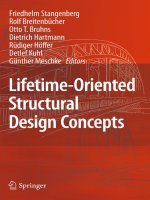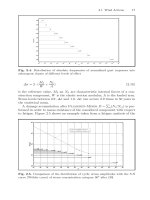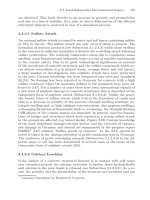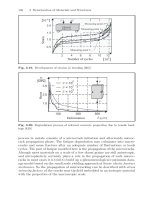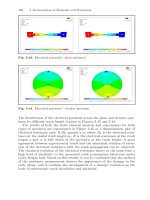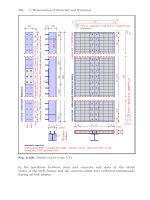Lifetime-Oriented Structural Design Concepts- P1 pdf
Bạn đang xem bản rút gọn của tài liệu. Xem và tải ngay bản đầy đủ của tài liệu tại đây (5.7 MB, 30 trang )
Lifetime-Oriented Structural Design Concepts
Friedhelm Stangenberg · Rolf Breitenbücher
Otto T. Bruhns · Dietrich Hartmann
Rüdiger Höffer · Detlef Kuhl
Günther Meschke (Eds.)
Lifetime-Oriented
Structural Design Concepts
ABC
Prof. Dr Ing. Friedhelm Stangenberg
Ruhr-University Bochum
Institute for Reinforced and
Prestressed Concrete Structures
Universitätsstr. 150
44780 Bochum, Germany
E-mail: sandra.krimpmann@
ruhr-uni-bochum.de,
friedhelm.stangenberg@
ruhr-uni-bochum.de
Prof. Dr Ing. Rolf Breitenbücher
Ruhr-University Bochum
Institute for Building Materials
Universitätsstr. 150
44780 Bochum, Germany
Prof. Dr Ing. Otto T. Bruhns
Ruhr-University Bochum
Institute of Mechanics
Universitätsstr. 150
44780 Bochum, Germany
Prof. Dr Ing. Dietrich Hartmann
Ruhr-University Bochum
Institute for Computational Engineering
Universitätsstr. 150
44780 Bochum, Germany
Prof. Dr Ing. Rüdiger Höffer
Ruhr-University Bochum
Building Aerodynamics Laboratory
Universitätsstr. 150
44780 Bochum, Germany
Prof. Dr Ing. Detlef Kuhl
University of Kassel
Institute of Mechanics and Dynamics
Mönchebergstr. 7
34109 Kassel, Germany
Prof. Dr Ing. Günther Meschke
Ruhr-University Bochum
Institute for Structural Mechanics
Universitätsstr. 150
44780 Bochum, Germany
ISBN 978-3-642-01461-1 e-ISBN 978-3-642-01462-8
DOI 10.1007/978-3-642-01462-8
Library of Congress Control Number: Applied for
c
2009 Springer-Verlag Berlin Heidelberg
This work is subject to copyright. All rights are reserved, whether the whole or part of the mate-
rial is concerned, specifically the rights of translation, reprinting, reuse of illustrations, recitation,
broadcasting, reproduction on microfilm or in any other way, and storage in data banks. Dupli-
cation of this publication or parts thereof is permitted only under the provisions of the German
Copyright Law of September 9, 1965, in its current version, and permission for use must always
be obtained from Springer. Violations are liable to prosecution under the German Copyright Law.
The use of general descriptive names, registered names, trademarks, etc. in this publication does
not imply, even in the absence of a specific statement, that such names are exempt from the relevant
protective la ws and regulations and therefore free for general use.
Typesetting by the Author.
Production: Scientific Publishing Services Pvt. Ltd., Chennai, India.
Cover Design: WMX Design GmbH, Heidelberg.
Printed in acid-free paper
30/3100/as 543210
springer.com
For Our Students, Colleagues and Engineers
in Industry and Academia
The Team of SFB 398
Mark Alexander Ahrens • Hussein Alawieh • Matthias Baitsch • Falko
Bangert • Yavuz Ba¸sar • Christian Becker • Ivanka Bevanda • J¨org Bock-
hold • Ndzi Christian Bongmba • Dietrich Braess • Rolf Breitenb¨ucher •
Otto T. Bruhns • Christian Duckheim • Andreas Eckstein • Frank Ensslen •
Olaf Faber • M´ozes G´alffy • Volkmar G¨ornandt • Jaroslaw Gorski • Stefan
Grasberger • Klaus Hackl • Ulrike Hansk¨otter • Gerhard Hanswille • Diet-
rich Hartmann • Anne Hartmann • Gunnar Heibrock • Martin Heiderich •
Jan Helm • Christa Hermichen • Erich Heymer • R¨udiger H¨offer • Norbert
H¨olscher • Jan-Hendrik Hommel • Wolfgang Hubert • Hur¸sit Ibuk • Mikhail
Itskov • Hans-Ludwig Jessberger • Daniel Jun • Dirk Kamarys • Michael
Kasperski • Christoph Kemblowski •Olaf Kintzel • Andr
eas
S. Kompalka •
Diethard K¨onig • Karsten K¨onke • Stefan Kopp • Wilfried B. Kr¨atzig • San-
dra Krimpmann • Jens Kruschwitz • Detlef Kuhl • Jan Laue • Armin Lenzen
• Roland Littwin • Ludger Lohaus • Dimitar Mancevski • G¨unther Meschke
• Kianoush Molla-Abbassi • J¨orn Mosler • Stephan M¨uller • Thomas Nerzak
• Hans-J¨urgen Niemann • Andrzej Niemunis • Sam-Young Noh • Markus
Peters • Lasse Petersen • Yuri Petryna • Daniel Pfanner • Tobias Pfister •
Gero Pflanz • Igor Plazibat • Rainer P¨olling • Markus Porsch • Thorsten
Quent • Stefanie Reese • Christian Rickelt • Matthias Roik • Jan Saczuk •
J¨org Sahlmen • E. Scholz • Henning Sch¨utte • Robert Schwetzke • Max J.
Setzer • Bj¨orn Siebert • Anne Spr¨unken • F
riedhelm Stangenberg • Zoran
Stank
ovic • Sascha Stiehler • Mathias Strack • Helmut Stumpf • Theodoros
Triantafyllidis • Cenk
¨
Ust¨undag • Heinz Waller • Claudia Walter • Heiner
Weber • Gisela Wegener • Andr´es Wellmann Jelic • Torsten Wichtmann •
Xuejin Xu • Natalia Yalovenko
Preface
At the beginning of 1996, the Cooperative Research Center SFB 398 finan-
cially supported by the German Science Foundation (DFG) was started at
Ruhr-University Bochum (RUB). A scientists group representing the fields
of structural engineering, structural mechanics, soil mechanics, material sci-
ence, and numerical mathematics introduced a research program on “lifetime-
oriented design concepts on the basis of damage and deterioration aspects”.
Two scientists from neighbourhood universities, one from Wuppertal and the
other one from Essen, joined the Bochum Research Center, after a few years.
The SFB 398 was sponsored for 12 years, until the beginning of 2008 – this
is the maximum possible duration of DFG financial support for an SFB.
Safety and reliability are important for the whole expected service duration
of an engineering structure. Therefore, prognostical solutions are needed and
uncertainties have to be handled. A differentiation according to building types
with different service life requirements is necessary. Life-cycle strategies to
control future structural degradations by concepts of appropriate design have
to be developed, in case including means of inspection, maintenance, and
repair. Aspects of costs and sustainability also matter.
The importance of structural life-cycle management is well recognized in
the international science community. Therefore, parallel corresponding ac-
tivities are proceeding in many countries. In Germany, two other related
SFBs were established: SFB 524 “Materials and Structures in Revitalisation
of Buildings” at Weimar University and the still running SFB 477 “Life-
Cycle Assessment of Structures via Innovative Monitoring” at Braunschweig
University of Technology. With these two SFBs, a fruitful cooperation was
developed.
The Cooperative Research Center for Lifetime-Oriented Design Concepts
(SFB 398) at Ruhr-University has carried out substantial work in many fields
of structural lifetime management. Lifetime-related fundamentals are pro-
vided with respect to structural engineering, structural and soil mechanics,
material science as well as computational methods and simulation techniques.
Stochastic aspects and interactions between various influences are included.
VIII Preface
Thus, a solid basis is provided for future practical use and, e.g. also for stan-
dardization.
The wide range of scientific topics among the specification and determina-
tion of external loading and the simulation based lifetime-oriented structural
design concepts is presented in an extraordinary format. All scientists of the
SFB 398, professors and Ph.D. students, have contributed with a great effort
in matchless team work to the present book. As a result of this, the present
work is not only a collection of project reports, in fact it is almost written
in the style of a monograph, whereby several authors fruitfully interact in all
sections from the highest to the deepest level. Within this philosophy of joint
authorship, authors are denoted in chapters and sections down to the third
level. In special cases, where authors have contributed to a selected deeper
section level, they are denoted beside the standard procedure in the regarding
text episode.
All members of SFB 398, with sincere thanks, acknowledge the financial
support of DFG over more than 12 years. The dedicated research work of all
participating colleagues and of many guest scientists from diverse countries
also is gratefully mentioned.
Finally, the great efforts of Springer-Verlag, Heidelberg, to produce this
attractive volume is appreciated very much.
Bochum, Friedhelm Stangenberg, Chairman of SFB 398
March 26th, 2009 Otto T. Bruhns, Vice-chairman of SFB 398
Contents
1 Lifetime-Oriented Design Concepts 1
1.1 Lifetime-Related StructuralDamage Evolution 1
1.2 Time-DependentReliabilityof Ageing Structures 3
1.3 Idea of Working-Life Related BuildingClasses 4
1.4Economicand Further Aspects of Service-Life Control 5
1.5 Fundamentals of Lifetime-Oriented Design 7
2 Damage-Oriented Actions and Environmental Impact 9
2.1 Wind Actions 9
2.1.1 Wind Buffeting with Relation toFatigue 10
2.1.1.1 Gust Response Factor 11
2.1.1.2 Number ofGustEffects 14
2.1.2 Influence of Wind Direction on Cycles ofGust
Responses 18
2.1.2.1 Wind Data in the Sectors oftheWind
Rosette 19
2.1.2.2 StructuralSafety Consideringthe
Occurrence ProbabilityoftheWind
Loading 22
2.1.2.3 Advanced DirectionalFactors 23
2.1.3 Vortex Excitation Including Lock-In 25
2.1.3.1 Relevant Wind Load Models 27
2.1.3.2 Wind Load Model fortheFatigue Analysis
of Bridge Hangers 29
2.1.4 Micro and MacroTime Domain 33
2.1.4.1 RenewalProcesses and Pulse Processes 34
2.2 ThermalActions 35
2.2.1 General Comments 35
2.2.2 ThermalImpacts on Structures 35
XContents
2.2.3 Test Stand 39
2.2.4 Modelling of Short Term ThermalImpacts and
Experimental Results 40
2.2.5 Application: ThermalActions on aCooling Tower
Shell 43
2.3 Transport and Mobility 46
2.3.1 Traffic Loads on Road Bridges
46
2.3.1
.1 General 46
2.3.1.2 BasicEuropeanTraffic Data 47
2.3.1.3 Basic Assumptions oftheLoad Modelsfor
Ultimate and ServiceabilityLimit States
in Eurocode 52
2.3.1.4 Principles fortheDevelopment of Fatigue
Load Models
62
2.3.1.5 ActualTraffic Trends and Required Future
Investigations 73
2.3.2 Aerodynamic Loads along High-Speed Railway
Lines 79
2.3.2.1 Phenomena 80
2.3.2.2 Dynamic Load Parameters 82
2.3.2.3 Load Pattern for Staticand Dy
namic
Design Calculatio
ns
87
2.3.2.4 DynamicResponse 90
2.4 Load-IndependentEnvironmentalImpact 92
2.4.1 Interactions ofExternalFactors Influencing
Durability 93
2.4.2 Frost Attack (with and without Deicing Agents)
95
2.4.2.1 The ”Frost Environment”: External
Factors and Frost Attack 96
2.4.2.2 Damage Due toFrost Attack 103
2.4.3 External ChemicalAttack 106
2.4.3.1 Sulfate Attack 107
2.4.3.2Calcium Lea
ching
107
2.5 GeotechnicalAspects 109
2.5.1 Settlement Due to Cyclic Loading 109
2.5.2 MultidimensionalAmplitude for Soilsunder Cyclic
Loading 114
3 Deterioration of Materials and Structures 123
3.1 Phenomena of MaterialDegradation on Various Scales 124
3.1.1 Load Ind
uced Degradati
on 124
3.1.1.1 QuasiStatic Loading in Cementitious
Materials 124
Contents XI
3.1.1.1.1 Fracture Mechanism of
Concrete Subjected toUniaxial
Compression Loading 124
3.1.1.1.2 Fracture Mechanism ofConcrete
Subjected toUniaxialTension
Loadings 125
3.1.1.1.3 Concrete under Multiaxial
Loadings 126
3.1.1.2Cyclic Loading 129
3.1.1.2.1 Ductile Mode of Deg
r
a
dation in
Metals 129
3.1.1.2.2Quasi-Brittle Damage 131
3.1.1.2.2.1 Cementitious
Materials 131
3.1.1.2.2.2 Metallic Materials 137
3.1.2 Non-mechanicalLoading 140
3.1.2.1 ThermalLoading 140
3.1.2.1.1 Degradation ofConcrete Due to
ThermalI
ncompat
ibilityof Its
Components 140
3.1.2.1.2 Stresses Due toThermal
Loading 141
3.1.2.1.3 Temperature and Stress
Development in Concrete at
the Early Age Due toHeat of
Hydration 142
3.1.2.2 Thermo-HygralLoading 143
3.1.2.2.1 HygralBehaviour of Hard
ened
Cement Paste
143
3.1.2.2.2 Influence ofCrackson the
Moisture Transport 147
3.1.2.2.3 Freeze Thaw 148
3.1.2.3 ChemicalLoading 150
3.1.2.3.1 Microstructure ofCementitious
Materials 150
3.1.2.3.2 Dissolution 152
3.1.2.3.3 Expansion 157
3.1.2.3.3.1 Sulpha
te Attac
k
on Concrete and
Mortar 157
3.1.2.3.3.2 Alkali-Aggregate
Reaction in
Concrete 158
3.1.3 Accumulation in Soils Due to Cyclic Loading:A
Deterioration Phenomenon? 160
XII Contents
3.2Experiments 163
3.2.1 LaboratoryTesting of StructuralMaterials 163
3.2.1.1 Micro-macrocrack DetectioninMetals 163
3.2.1.1.1 ElectricResistance
Measurements 163
3.2.1.1.1.1 Introduction 163
3.2.1.1.1.2 Measurement of
the Electrical
Resistance 165
3.2.1.1.1.3 Calculation oft
he
Electrical Resista
nce .
. 166
3.2.1.1.1.4Experiments 166
3.2.1.1.1.5 Experimental
Results 167
3.2.1.1.2 AcousticEmission 169
3.2.1.1.2.1 Location of
AcousticEmission
Sources 171
3.2.1.1.2.2 Linear Location of
AcousticEmission
Sources 171
3.2.1
.1
.2.3
Location of Sources
in Two Dimensions 171
3.2.1.1.2.4 Kaiser Effect 172
3.2.1.1.2.5 Experimental
Procedures 172
3.2.1.1.2.6 Experimental
Results 174
3.2.1.2 Degradation ofConcrete Subjected to
CyclicCompressive Loading 180
3.2.1
.2.1
Test Series andExperimental
Strategy 180
3.2.1.2.2 Degradation Determined by
Decrease of Stiffness 182
3.2.1.2.3 Degradation Determined by
Changes in Stress-Strain
Relation 183
3.2.1.2.4 Adequate Description of
Degradation byFatigue Strain 185
3.2.1
.2.5 Beh
aviour of High Strength
Concrete and Air-Entrained
Concrete 187
3.2.1.2.6 Influence of Various Coarse
Aggregates and Different
GradingCurves 189
Contents XIII
3.2.1.2.7Cracking in the Microstructure
Due to Cyclic Loading 190
3.2.1.2.8 Influence of Single Rest Periods . . . 191
3.2.1.2.9 Sequence Effect Determined by
Two-Stage Tests 193
3.2.1.3 Degradation ofConcrete Subjected to
Freeze Thaw 194
3.2.2 High-Cycle LaboratoryTest
s on
S
oils 198
3.2.3 StructuralTesting ofComposite Structures of Steel
andConcrete 2 07
3.2.3.1 General 207
3.2.3.2 Basic Tests fortheFatigue Resistance of
Shear Connectors 212
3.2.3.2.1 Test Program 212
3.2.3.2.2 Test Spe
cimens
215
3.2.3.2.3 Test Setup and Loading
Procedure 216
3.2.3.2.4 MaterialProperties 217
3.2.3.2.5 Results ofthePush-Out Tests 219
3.2.3.2.5.1 General 219
3.2.3.2.5.2 Results ofthe
Constant Amplitude
Tests .
219
3.2.3.2.6 Results oftheTests with
Multiple Blocks of Loading 222
3.2.3.2.7 Results oftheTests Regarding
the Mode Control andtheEffect
of Low Temperature 223
3.2.3.2.8 Results oftheTests Regarding
Crack Initiation andCrack
Propagation 225
3.2.3
.3 Fatigu
e Tests of Full-ScaleComposite
Beams 225
3.2.3.3.1 General 225
3.2.3.3.2 Test Program 226
3.2.3.4 Test Specimen 227
3.2.3.5 Test Setup 227
3.2.3.6 MaterialProperties 231
3.2.3.7 Main Results oftheBeam Tests 232
3.
3 M
odelling 236
3.3.1 Load Induced Damage 237
3.3.1.1 Damage in Cementitious Materials
Subjected to QuasiStatic Loading 237
3.3.1.1.1 Continuum-Based Models 237
XIV Contents
3.3.1.1.1.1 Damage Mechanics-
Based Models 238
3.3.1.1.1.2Elastoplastic Models 244
3.3.1.1.1.3 Coupled
Elastoplastic-
Damage Models 244
3.3.1.1.1.4 Multisurface
Elastoplastic-
Damage Model for
Concrete 246
3.3.1.1.2 Embedded Crack Models 252
3.3.1.2Cyclic Loading
255
3.3.1.2.1 Mechanism-Oriented Simulation
of Low Cycle Fatigue of Metallic
Structures 255
3.3.1.2.1.1 Macroscopic
Elasto-Plastic
Damage Model for
Cyclic Loading 256
3.3.1.2.1.2 ModelValidation 259
3.3.1.2.2Q
u
a
si-Brittle Damage in
Materials 261
3.3.1.2.2.1 Cementitious
Materials 261
3.3.1.2.2.2 Metallic Materials 270
3.3.2 Non-mechanicalLoadingand Interactions 285
3.3.2.1 Thermo-Hygro-MechanicalModelling of
Cementitious Mat
erials -Shrinkage
and
Creep 285
3.3.2.1.1 Introductory Remarks 285
3.3.2.1.2 State Equations 286
3.3.2.1.3 Identification ofCoupling
Coefficients 288
3.3.2.1.4Effective Stresses 289
3.3.2.1.5 Multisurface Damage-Plasticity
Model for Partially
Satu
rated
Concrete 290
3.3.2.1.6 Long-Term Creep 291
3.3.2.1.7 Moisture and Heat Transport 292
3.3.2.1.7.1 Freeze Thaw 293
3.3.2.2Chemo-MechanicalModelling of
Cementitious Materials 294
3.3.2.2.1 Modelsfor Ion Transport and
Dissolutio
n
Processes .
295
Contents XV
3.3.2.2.1.1 Introductory
Remarks 295
3.3.2.2.1.2 InitialBoundary
Value Problem 296
3.3.2.2.1.3 Constitutive Laws 297
3.3.2.2.1.4 Migration of
Calcium Ions
in Water and
Electrolyte
Solutions 298
3.3.2.2.1.5 Evo
lution
Laws 300
3.3.2.2.2 ModelsforExpansive Processes 302
3.3.2.2.2.1 Introductory
Remarks 302
3.3.2.2.2.2 Balance Equations . . . 305
3.3.2.2.2.3 Constitutive Laws 307
3.3.2.2.2.4 Model Calibration . . . . 311
3.3.3 A High-Cycle Model for So
ils .
313
3.3.4 ModelsfortheFatigue Resistance ofComposite
Structures 316
3.3.4.1 General 316
3.3.4.2 Modelling oftheLocalBehaviour of Shear
Connectors in the Case ofCyclic Loading 317
3.3.4.2.1 Static Strength of Head
ed Shea
r
Studs without Any Pre-damage 317
3.3.4.2.2 Failure Modes of Headed Shear
Studs Subjected toHigh-Cycle
Loading 322
3.3.4.2.3 Correlation between the
Reduced Static Strength and
the GeometricalPropertyofthe
Fatigue Fracture Are
a 327
3.3.4.2.4 Life
time -Number ofCycles
toFailure Based on Force
Controlled Fatigue Tests 329
3.3.4.2.5 Reduced Static Strength over
Lifetime 330
3.3.4.2.6 Load-Slip Behaviour 332
3.3.4.2.7CrackInitiation andCrack
Development .
334
3.3.4.2.8 I
mproved Damage Accumulation
Model 337
3.3.4.2.9 Ductility andCrackFormation . . . 341
XVI Contents
3.3.4.2.10 Finite ElementCalculations of
the (Reduced)Static Strength
of Headed Shear Studs in
Push-Out Specimens 341
3.3.4.2.11 Effect oftheControl Mode -
Effect of Low Temperatures 344
3.3.4.3 Modelling of the GlobalBehaviour of
Composite Beams Subjected
to C
y
clic
Loading 345
3.3.4.3.1 MaterialModel fortheConcrete
Behaviour 345
3.3.4.3.2Effect of High-Cycle Loading
on Load Bearing Capacityof
Composite Beams 346
3.3.4.3.3 Cyclic Behaviour ofComposite
Beams -Development of Slip
349
3.3.4.3.4Effect ofCyc lic Loading on
Beams with Tens ion Flanges 350
3.4 Numerical Examples 351
3.4.1 DurabilityAnalysis ofaConcrete TunnelShell 351
3.4.2 DurabilityAnalysis ofaCementitious Bea
m
Exposed to Calc
ium LeachingandExternal
Loading 354
3.4.3 DurabilityAnalysis ofaSealed Panelwith a
Leakage 356
3.4.4 NumericalSimulation ofaConcrete Beam Affected
byAlkali-Silica Reaction 359
3.4.5 Lifetime Assessment ofaSphericalMetallic
Container
362
4 Methodological Implementation 365
4.1 Fundamentals 365
4.1.1 Classification of Deterioration Problems 366
4.1.2 NumericalMethods 368
4.1.3 Uncertainty 369
4.1.4 Design 370
4.2 NumericalMethods 372
4.2.1 Generalization of Single- and Multi-field Models
372
4.2.1
.1 IntegralFormat of Balance Equations 373
4.2.1.2 Strong Form of IndividualBalance
Equations 374
4.2.2 Strategyof NumericalSolution 376
4.2.3 Weak Formulation 377
4.2.3.1 Weak Form ofCoupled Balance
Eq
uations 377
Contents XVII
4.2.3.2 Linearized Weak Form ofCoupled Balance
Equations 378
4.2.4 SpatialDiscretization Methods 379
4.2.4.1 Introduction 379
4.2.4.2Generalized Finite Element Discretization
of Multifield Problems 380
4.2.4.2.1
Approxima
tions 380
4.2.4.2.2 Non-Linear Semidiscrete
Balance 383
4.2.4.2.3 Linearized Semidiscrete Balance 385
4.2.4.2.4Generation ofElementand
Structural Quantities 386
4.2.4.3 p-F
inite Element Meth
od 387
4.2.4.3.1 OnedimensionalHigher-Order
Shape Function Concepts 389
4.2.4.3.1.1 Shape Functions of
the Legendre-Type 389
4.2.4.3.1.2Comparison of Both
Shape Function
Concepts
390
4.2.4.3.
2 3D-p-Finite Element Method
Based on HierarchicalLegendre
Polynomials 392
4.2.4.3.2.1 Generation of
3D-p-Shape
Functions 392
4.2.4.3.2.2 Spatially
Anisotropic
Approximation
Orders 394
4.2.4.3
.2.3
Field-wise
Choice of
the Approximation
Order 397
4.2.4.3.2.4Geometry
Approximation 402
4.2.5 Solution of StationaryProblems 403
4.2.5.1 NumericalSolution Technique 403
4.2.5.2 Iteration Methods 403
4.2.5.3 Arc-Length Control
led Analysis
407
4.2.6 TemporalDiscretization Methods 408
4.2.6.1 Introduction 409
4.2.6.1.1 Motivation 410
4.2.6.1.2 Newmark-α Time Integration
Schemes 411
XVIII Contents
4.2.6.1.3 Galerkin Time Integration
Schemes 411
4.2.6.2 Newmark-α Time Integration Schemes 412
4.2.6.2.1 Non-linear Semidiscrete Initial
Value Problem 412
4.2.6.2.2 Numerical Concept of
Newmark-α Time Integration
Schemes 413
4.2.6
.
2.3
Time Discretization 414
4.2.6.2.4 Approximation of State
Variables 414
4.2.6.2.5 Algorithmic Semidiscrete
Balance Equation 415
4.2.6.2.6 Effective Balance Equation 415
4.2.6.2.7 Newmark-α Algorithm
416
4.2.6.3 Discontinuous andContinuous Galerkin
Time Integration Schemes 416
4.2.6.3.1 Time Discretization 418
4.2.6.3.2Continuity Condition 418
4.2.6.3.3 TemporalWeak Form 419
4.2.6.3.4 Linearization 419
4.2.6
.3.5
Temporal Galerkin
Approximation 419
4.2.6.3.6 Discontinuous Bubnov-Galerkin
Schemes dG(p) 421
4.2.6.3.7Continuous Petrov-Galerkin
Schemes cG(p) 422
4.2.6.3.8 Newton-Raphson Iteration 422
4.2.6.3.9 Algorithmic Set-Up ofGaler
kin
Sch
emes 422
4.2.7Generalized ComputationalDurabiltyMechanics 424
4.2.8 AdaptivityinSpace and Time 425
4.2.8.1 Error-Controlled SpatialAdaptivity 425
4.2.8.1.1 VariationalFunctional 427
4.2.8.1.2 Interpolati
on 428
4.2.8.1.3
Stress Computation 428
4.2.8.1.4 Discretized Weak Form 429
4.2.8.1.5 Summary 430
4.2.8.1.6 Hanging Node Concept 431
4.2.8.1.7ErrorCriteria 431
4.2.8.1.7.1 Warping-Based
ErrorCriterion 431
4.2.8.1
.7.2Re
sidual-Based
ErrorCriterion 432
4.2.8.1.8 Program Flow 433
Contents XIX
4.2.8.1.9 Transfer of HistoryVariables 434
4.2.8.1.10 Examples 434
4.2.8.1.10.1 UniaxialBending
(Beam of Uniform
Thickness) 434
4.2.8.1.10.2 UniaxialBending
(Beam of Variable
Thickness)
437
4.2.8.1
.1
0.3 BiaxialBending
(Thick Plate of
Uniform Thickness) 439
4.2.8.2Error-Controlled TemporalAdaptivity 443
4.2.8.2.1 Local a Posteriori h- and
p-MethodErrorEstimates 443
4.2.8.2.2 Local a Post
eriori h- and
p-MethodE
rror Indicators 444
4.2.8.2.3 Local Zienkiewicz a Posteriori
Error Indicators 444
4.2.8.2.4 Adaptive Time Stepping
Procedure 446
4.2.8.2.5
Algorithmic Set-Up
447
4.2.9 Discontinuous Finite Elements 448
4.2.9.1 Overview and Motivation 448
4.2.9.2Concepts 449
4.2.9.2.1 Extended Finite Element
Method (XFEM) 449
4.2.9.2.1.1 Partitio
n
of Unity.
449
4.2.9.2.1.2 XFEM
Displacement
Field 452
4.2.9.2.1.3 Integrating
Discontinuous
Functions 458
4.2.9.2.1.4 p-Version ofthe
XFEM 469
4.2.9.2.1.5 3D XFEM 473
4.2.9.2.1.6 XFEM forCohesive
Cr
ac
ks 476
4.2.9.2.2 Strong DiscontinuityApproach
andEnhanced Assumed Strain . . . 479
4.2.9.2.2.1 Kinematics:
Modeling
Embedded Strong
Discontinuities 479
XX Contents
4.2.9.2.2.2 Numerical
Implementation 482
4.2.9.2.2.3 Numerical Example:
3-Point Bending
Problem 486
4.2.9.3 Cra ckgrowth Criteria 488
4.2.9.3.1 Hoop Stresses 489
4.2.9.3.2 Mode-I-Crack Extension 490
4.2.9.3.3 Minimum Ener
gy 492
4.2.9
.4Examples 493
4.2.9.4.1 Double Notched Slab 493
4.2.9.4.2 Anchor Pull-Out 494
4.2.10 Substructuringand Model Reduction of Partially
Damaged Structures 498
4.2.10.1 Motivation andOverview 499
4.2.
10.2Concept
501
4.2.10.3 Derivation ofaSubstructure Technique for
Nonlinear Dynamics 502
4.2.10.3.1 Craig-Bampton Method 502
4.2.10.3.2 Model Reduction of Linear
Dynamic Structures 503
4.2.10.3.2.1 Modal Reduction 503
4.2.10.3.2.2 Proper Orthogonal
Decomposition 504
4.2.
10.3.2.3
Pad´e-Via-Lanczos
Algorithm 504
4.2.10.3.2.4 Load-Dependent
Ritz Vectors 506
4.2.10.3.3 Substructuring in the
Framework of Nonlinear
Dynamics 506
4.2.10.3.3.1 Discretisation and
Linearisation 506
4.2.10.3.3.2 PrimalAssembly 509
4.2.10.3.3.3 Solutio
n
oft
he
Decomposed
Structure 511
4.2.10.4Example 512
4.2.11 Strategy for Polycyclic Loading of Soil 517
4.3 System Identification 519
4.3.1 Covariance Analysis 520
4.3.2 Subspace Methods 520
4.3.2.1 State Space Model 520
4.3.2.2 Subspa
ce Ident
ification 522
4.3.2.3 ModalAnalysis 527
Contents XXI
4.4ReliabilityAnalysis 528
4.4.1 GeneralProblem Definition 529
4.4.2 Time-Invariant Problems 531
4.4.2.1 Approximation Methods 531
4.4.2.2 Simulation Methods 533
4.4.2.2.1 Importance Sampling
534
4.4.2.2.2 Latin Hype
rcube Sampling 535
4.4.2.2.3 Subset Methods 536
4.4.2.3 Response Surface Methods 537
4.4.2.4Evaluation of Uncertainties andChoice of
Random Variables 539
4.4.3 Time-Variant Problems
540
4.4.3.1
Time-Integrated Approach 540
4.4.3.2 Time Discretization Approach 540
4.4.3.3 Outcrossing Methods 541
4.4.4 Parallelization ofReliabilityAnalyses 542
4.4.4.1 ReliabilityAnalysis of Fatigue Processes
543
4.4.4.2 Para
llelization Example 544
4.5 Optimization and Design 545
4.5.1 Classification ofOptimization Problems 546
4.5.2 Design as an Optimization Problem 547
4.5.3 Numerical Optimiza
tion Meth
ods 551
4.5.3.1 Derivative-Based Methods 552
4.5.3.2 Derivative-Free Strategies 555
4.5.4 Parallelization ofOptimization Strategies 559
4.5.4.1 Parallelization with Gradient-Based
Algorithms 560
4.5.4.2 Parallelization UsingEvolution Strategies
560
4.5.
4.3 Distributed and ParallelSoftware
Architecture 561
4.6 Application of Lifetime-Oriented Analysisand Design 561
4.6.1 Testing of Beam-Like Structures 562
4.6.1.1 ExperimentalSetup 563
4.6.1.2 Identification of ModalData 563
4.6.1.3 Updating oft
heFini
te
Element Model 566
4.6.2 Lifetime Analysisfor Dynamically Loaded
Structures at BMW AG 572
4.6.2.1 Works fortheNew3-Series Convertible 572
4.6.2.2 The Shaker Test 574
4.6.2.3 Approach 1: Time History Calculation and
Amplitude Counting .
574
4.6.
2.3.1 StructuralAnalysis Using Time
Integration 575
4.6.2.3.2CycleCounting Usingthe
Rainflow Method 575
XXII Contents
4.6.2.3.3 Damage Calculation 576
4.6.2.4 Approach 2:Power SpectralDensity
FunctionsandCalculation of Spectral
Moments 577
4.6.2.4.1 StructuralAnalysis Using
Power SpectralDensity (PSD)
Functions 577
4.6.2.4.2 Analytical Counting Met
hod
. 578
4.6.2.4.3 Damage Accumulation forthe
Analytical Case 579
4.6.2.5 Comparison oftheResults 580
4.6.2.6 Summary andOutlook 582
4.6.3 Lifetime-Oriented Analysis ofConcrete Structures
Subjected to EnvironmentalAtta
ck .
583
4.6.3.1 Hygro-MechanicalAnalysis ofaConcrete
Shell Structure 583
4.6.3.1.1 ConclusiveRemarkson the
Hygro-MechanicalAnalys is 590
4.6.3.2Calcium Leaching ofCementitious
Materials 591
4.6.3.2.1 Calcium Leaching ofa
Cementitious Bar .
592
4.6.3.2.1.1 Analysis ofthe
Numerical Results 592
4.6.3.2.1.2 Adaptive Newmark
Solution 594
4.6.3.2.1.3 Robustness of
Galerkin Solutions 594
4.6.3.2.1.4ErrorEstimates for
Newmark Solutions 594
4.6.3.2.1.5 ErrorEstimates for
Galer
kin Solut
ions 598
4.6.3.2.1.6 Order of Accuracy
ofGalerkin Schemes . . 600
4.6.3.2.2Calcium Leaching ofa
Cementitious Beam 601
4.6.3.2.2 .1 Analysis ofthe
Numerical Results 602
4.6.3.2.2.2Robustness of
Continuous
Galerkin Solutions 603
4.6
.4 Arched Ste
elBridge Under Wind Loading 607
4.6.4.1 Definition of StructuralProblem 607
4.6.4.2 Probabilistic Lifetime Assessment 610
4.6.4.2.1 MicroTime Scale 610
Contents XXIII
4.6.4.2.2 MacroTime Scale 611
4.6.4.3 Results of Structural Optimization 613
4.6.4.4 Parallelization of Analyses 614
4.6.4.5 Final Conclusion 615
4.6.5 Arched Reinforced Concrete Bridge 616
4.6.5.1 NumericalSimulation 617
4.6.5.1.1 ExperimentalInvestigatio
n on
Mechani
cal Concrete Properties 618
4.6.5.1.1.1 Non-destructive
Tests 618
4.6.5.1.1.2 Destructive Tests 619
4.6.5.1.1.3 Microscopic
Analysis 621
4.6.5.1.1.4Cyclic Tests 621
4.6.5.1.2 Finite Element Model 624
4.6.5.1.3 MaterialModel 625
4.6.5.1.4 Damage Mechanisms 625
4.6
.5.1
.4.1 Corrosion ofthe
Reinforcement Steel
Bars 625
4.6.5.1.4.2 Fatigue ofthe
Prestressing
Tendons 626
4.6.5.1.5 Modelling of Uncertainties 627
4.6.5.1.5.1 Long-Term
Developement of
Concrete Strength 628
4.6.5.1.5.2 Determination of
MaterialPrope
rties .
. . 630
4.6.5.1.5.3 Modelling of Spatial
Scatter by Random
Fields 631
4.6.5.1.6 Lifetime Simulation 632
4.6.5.1.7Conclusions 634
4.6.5.2ExperimentalVerification 634
4.6.5.2.1 State Space Model for
MechanicalStructures 635
4.6.5.2.2 White Box Model-Physical
Int
erp
retable Parameters 636
4.6.5.2.3 Identification of Measured
MechanicalStructures 637
4.6.5.2.3.1 Black Box Model-
Deterministic
System
Identification 637
XXIV Contents
4.6.5.2.3.2 Differences between
Theory and
Experiment 638
4.6.5.2.4Experiments 641
4.6.5.2.4 .1 Ca ntilever Bending
Beam 641
4.6.5.2.4.2 Tied-Arch
Bridge near
H¨unxe - Germany 642
4.6.5.2.5 Conclusion 645
4.6.6 Examples
fo
rt
hePrediction of Settlement Due to
Polycyclic Loading 646
5 Future Life Time Oriented Design Concepts 653
5.1 Exemplary Realization of Lifetime Control UsingConcepts
as Presented Here 653
5.1.1 Reinforced Concrete Column under Fatigue Load 653
5.1.2Connection Plates ofanArc
hed SteelBridg
e 655
5.1.3 Conclusion 658
5.2 Lifetime-Control Provisions in Current Standardization 658
5.3 Incorporation intoStructural Engineering Standards 659
References 661
Subject Index 711
List of Figures
1.1 Lifetime-related a spects of structural concrete 2
1.2Evolution ofdegradation 2
1.3 Time-dependentreliabilityof structures 3
1.4 Time-dependentreliabilityof structures with upgradingby
repairs 4
1.5 Working-life related buildingclasses 5
1.6 Service Life control andeconomic aspects 6
1.7Related Collaborative Research Centers 6
2.1 Typicalwind load process (a), andrelated low frequency(b)
andhigh frequency(c) response of a structure [572] 10
2.2Curve ofthetotalvariance of the base bendingmoment ofa
cantilever due to buffetingexcitation plotted over frequencies
[572] 12
2.3 Comparison oftheoccurence of repeated windeffects at
different locations in Germany andacodified representation . . . 15
2.4 Distribution ofabsolute frequencies of normalized gust
responses into subsequentclasses ofdifferent levels ofeffect 17
2.5 Comparison of the distribution ofcyclicstressamplitudes
with the S-N curve (W¨ohler curve)of stress concentration
category 36* after [30] 17
2.6 Rosettes of windquantities at Hannover (12 sectors,50years
return period) 18
2.7Roughness lengths of the terrain in the farther vicinityofthe
building location [771] 21
2.8 Sketch ofabuildingcontour andfa¸cade elementexposed to a
pressure coefficient c
p
= −1.4 [32] 21
2.9 Von K
´
arm
´
an vortex trail formed byvortex shedding 26
2.10 Dependence ofthevortex sheddingfrequency f
v
on the wind
velocity¯u. f
n
isthenatural frequencyof the structure 27
XXVI List of Figures
2.11 Wind velocity, measured andsimulated deflection vs. time
for the bridge hanger 1(left) and2(right) 30
2.12 Width ofthelock-in range forbridge tierods 32
2.13 Measured andsimulated amplitude ofthedisplacement
within and outside ofthelock-in range .
33
2.14 Sampler
ealizations ofarenewal process (left) and ofa
pulse-process (right) 34
2.15 Wavelength ofthevisible light 38
2.16 Climatic load on a structure 38
2.17 Test standfortheanalysis ofthermal actions on concret
e
spec
imen 40
2.18 Measured temperature profile duringasummerday 41
2.19 Rainflow analysis ofthemacroscopic temperature behaviour 42
2.20Temperature b ehaviour due to a sudden change in solar
radiation 43
2.21Temperature distributions determined at 16 layers within a
coolingtower shell under constantexternall
oad ac
tions 44
2.22 Effect ofthemeanwind speed on the development ofthe
temperature difference ofacoolingtower shell 45
2.23Frequency distribution ofthetotalweight G ofthe
representative lorries per 24 hours based on trafficdataof
Auxerre in France (1986) 48
2.24 Gross vehicleandaxle weigh
t dist
ribution ofrecorded traffic
data fromEngland,France andGermany 48
2.25Histogram of vehicle Type 3 and approximation by two
separate distribution functions 49
2.26 Comparison ofmeasuredandtheoreticalvalue
s forth
e
density function of intervehicledistances 51
2.27 Model forthevehicles and localirregularities andpower
spectral densityof the pavement 53
2.28 Eigenvalues of the first mode ofsteel andconcrete Bridges
[169] . . . . . . . . . . . . . . . . . . . . . . . . . . . . . . . . . . . . . . . . . . . . . . . . . . . 54
2.29 Cum
ulativefr
equencyoftheaction effects fordifferent
vehicle speeds [530] . . . . . . . . . . . . . . . . . . . . . . . . . . . . . . . . . . . . . . . 55
2.30 Influence ofthequalityof the pavement on the dynamic
amplification factor ϕ [530] 56
2.31 Influence ofthespanlength andthenumber of loaded lanes
on the dynamicamplification factor ϕ 56
2.32 Additio
nal dynamicf
a
ctor Δϕ taking into account
irregularities of the pavement [9] 57
2.33 Determination of the characteristic values oftheaction
effects fromtherandomgenerations of loads 58
2.34 Load Model1accordingto Eurocode 1-2 59
2.3
5 Compa
rison oftheLoad Model1inEurocode -2 with the
characteristic values obtained fromreal trafficsimulations 59

